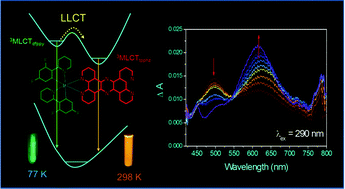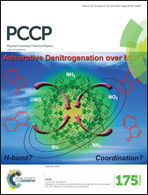Ligand-to-ligand charge transfer in heteroleptic Ir-complexes: comprehensive investigations of its fast dynamics and mechanism†
Abstract
To gain new insights into ligand-to-ligand charge-transfer (LLCT) dynamics, we synthesised two heteroleptic Ir3+ complexes: (Ir(dfppy)2(tpphz)) and (Ir(dfppy)2(dpq)), where dfppy, tpphz, and dpq are 2-(4,6-difluorophenyl)pyridine, tetrapyrido[3,2-a:2′,3′-c:3′′,2′′-h:2′′′,3′′′-j]phenazine, and 2,3-bis-(2-pyridyl)-quinoxaline, respectively. The tpphz and dpq ligands have longer π-conjugation than dfppy. Therefore, the excited ligand-centred (LC) state and the metal-to-ligand charge transfer (MLCT) state of dfppy are higher than those of tpphz and dpq. The LLCT dynamics from dfppy to tpphz (or dpq) was probed using femtoscond transient absorption (TA) spectroscopy after the selective excitation of dfppy. The TA band for the LC/MLCT state of dfppy is observed at 480 nm. Because of the LLCT process, the TA bands related to the MLCT states of tpphz and dpq ligands increased, whereas those of dfppy decreased. The time constants for the LLCT process were 17 ps for Ir(dfppy)2(tpphz) and 5 ps for Ir(dfppy)2(dpq). The MLCT emission of Ir(dfppy)2(tpphz) showed strong temperature dependence, indicating that the LLCT process has a significant energy barrier. In comparison, the temperature weakly influenced the emission of Ir(dfppy)2(dpq), and thus, its LLCT process may have a smaller barrier. The anomalous rigidochromism and photodynamic behaviours can be explained in terms of the barrier between cyclometalating and ancillary ligands.


 Please wait while we load your content...
Please wait while we load your content...